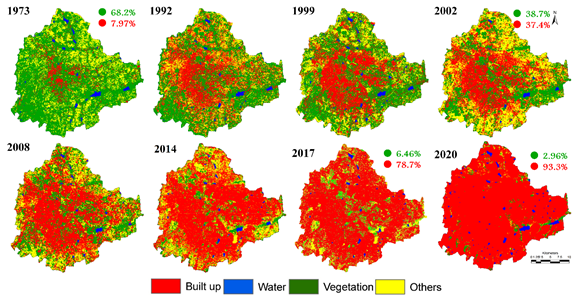|
|
Stop Unplanned Urbanaisation in Bangalore: Non-Resilient and Unlivable With Unabated Senseless Concretisation
1028% increase in paved surface during 1973 to 2017 (Figure 4.1)
Solution: Enough is Enough, DECONGEST BANGALORE.
- SHIFT MAJOR INSTALLATIONS TO OTHER CITIES IN KARNATAKA,
- STOP FURTHER INDUSTRIAISATION AND COMMERCIAL ESTABLISHMENTS IN BANGALORE.
- PROTECT OPEN SPACES – LAKES, PARKS, ETC.
- STOP FURTHER GROWTH OF DYING CITY – WITH WATER AND OXYGEN SCARCITY
- BWSSB SHOULD STOP ISSUING NOC (No Objection certificate) TO MAJOR BUILDING PROJECTS AS THERE IS NOT SUFFICIENT WATER (either Cauvery water or Groundwater) IN THE CITY.
Bangalore is experiencing unprecedented rapid urbanisation and sprawl in recent times due to unrealistic concentrated developmental activities. This has led to the large scale land cover changes with serious environmental degradation, posing serious challenges to the decision makers in the city planning and management process involving a plethora of serious challenges such as climate change, enhanced emissions of greenhouse gases (GHG), lack of appropriate infrastructure, traffic congestion, and lack of basic amenities (electricity, water, and sanitation) in many localities, etc.

Figure 4.1: Land use dynamics in Bengaluru
Table 4.1: Land use dynamics of Bangalore
Area |
Land use \ Class |
1973 |
1992 |
1999 |
2002 |
2008 |
2014 |
2017 |
2020 |
Hectare |
Built up |
5683 |
19452 |
25202 |
26890 |
35301 |
46626 |
56046 |
66455 |
Vegetation |
48650 |
32937 |
32616 |
27590 |
20090 |
5986 |
4603 |
2108 |
Water |
2424 |
1867 |
1608 |
1317 |
613 |
527 |
734 |
1491 |
Others |
14503 |
17004 |
11834 |
15462 |
15256 |
18121 |
9877 |
1206 |
Percentage |
Built up |
7.97 |
27.30 |
35.37 |
37.74 |
49.54 |
65.43 |
78.65 |
93.26 |
Vegetation |
68.27 |
46.22 |
45.77 |
38.72 |
28.19 |
8.40 |
6.46 |
2.96 |
Water |
3.40 |
2.62 |
2.26 |
1.85 |
0.86 |
0.74 |
1.03 |
2.09 |
Others |
20.35 |
23.86 |
16.61 |
21.70 |
21.41 |
25.43 |
13.86 |
1.69 |
Urbanisation and loss of natural resources (wetlands and green spaces): Urbanisation during 1973 to 2017 (1028% concretization or increase of paved surface) has telling influence on the natural resources such as decline in green spaces (88% decline in vegetation), wetlands (79% decline), higher air pollutants and sharp decline in groundwater table. Figure 4.1 depicts the unrealistic urban growth during the last two decades. Quantification of number of trees in the region using remote sensing data with field census reveals that there are only 1.5 million trees to support Bangalore's population of 9.5 million, indicating one tree for every seven persons in the city. This is insufficient even to sequester respiratory carbon (ranges from 540-900 g per person per day). Geo-visualisation of likely land uses in 2020 through multi-criteria decision making techniques (Fuzzy-AHP: Analytical Hierarchal Process) reveals calamitous picture of 93% (Table 4.1) of Bangalore landscape filled with paved surfaces (urban cover) and drastic reduction in open spaces and green cover. This would make the region GHG rich, water scarce, non-resilient and unlivable, depriving the city dwellers of clean air, water and environment.
|
Dr. T.V. Ramachandra
Centre for Sustainable Technologies, Centre for infrastructure, Sustainable Transportation and Urban Planning (CiSTUP), Energy & Wetlands Research Group, Centre for Ecological Sciences, Indian Institute of Science, Bangalore – 560 012, INDIA.
E-mail : tvr@iisc.ac.in
Tel: 91-080-22933099/23600985,
Fax: 91-080-23601428/23600085
Web: http://ces.iisc.ac.in/energy
Vinay SEnergy & Wetlands Research Group, Centre for Ecological Sciences, Indian Institute of Science, Bangalore – 560 012, INDIA.
E-mail: svinay@iisc.ac.in
Sudarshan BhatEnergy & Wetlands Research Group, Centre for Ecological Sciences, Indian Institute of Science, Bangalore – 560 012, INDIA.
E-mail: sudarshanb@iisc.ac.in
Bharath SetturEnergy & Wetlands Research Group, Centre for Ecological Sciences, Indian Institute of Science, Bangalore – 560 012, INDIA.
E-mail: setturb@iisc.ac.in
Bharath H. AithalEnergy & Wetlands Research Group, Centre for Ecological Sciences, Indian Institute of Science, Bangalore – 560 012, INDIA.
E-mail: bharathh@iisc.ac.in
Citation:Ramachandra T V, Vinay S, Sudarshan Bhat, Bharath Settur, Bharath H. Aithal, 2017. Unabated Violations in Agara Bellandur Wetland, ENVIS Technical Report 134, Environmental Information System, CES, Indian Institute of Science, Bangalore 560012
| Contact Address : |
| |
Dr. T.V. Ramachandra
Energy & Wetlands Research Group,
Centre for Ecological Sciences, TE 15, New Biology Building, Third Floor, E Wing, [Near D Gate], Indian Institute of Science, Bangalore – 560 012, INDIA.
Tel : 91-80-22933099 / 22933503-extn 107
Fax : 91-80-23601428 / 23600085 / 23600683 [CES-TVR]
E-mail : tvr@iisc.ac.in, energy@ces.iisc.ac.in,
Web : http://wgbis.ces.iisc.ac.in/energy |
|